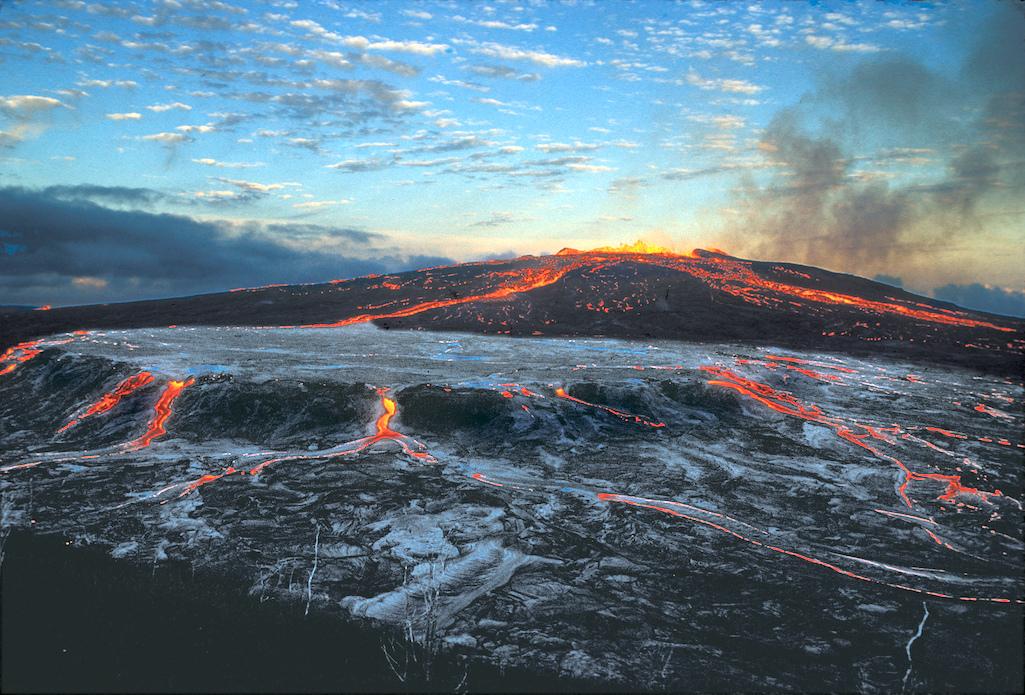
A 1969-1974 eruption of Mauna Ulu put on a spectacular show. This photo was from 1974/NPS files
No one is predicting that Mauna Loa, the world's largest volcano that is surrounded by Hawai'i Volcanoes National Park is about to erupt, but at the same time U.S. Geological Survey staff in Hawai'i say you should be prepared.
According to the National Park Service, "(E)ruptions of Mauna Loa have historically been characterized by high volume flows that produce lava capable of traveling long distances, contributing to its shape. Scientists believe that 90 percent of the volcano's surface has been covered with flows that erupted within the past 4,000 years."
With that knowledge as a background, consider that Mauna Loa this year has shuddered with hundreds of "small-magnitude earthquakes," which USGS defines as generating a magnitude of less than 2.5. This past week, for instance, there were 134 such earthquakes on the volcano that rises 13,681 feet above the Pacific Ocean.
Across the park, the Kīlauea Volcano resumed its eruptions in December.
Manua Loa's past eruptions -- the last was in 1984 -- suggest residents and visitors to the Big Island should be prepared to get out of the way if Mauna Loa does erupt.
Mauna Loa eruptions tend to produce voluminous, fast-moving lava flows that can impact communities on the east and west sides of the Island of Hawaiʻi. Since the mid-19th century, the city of Hilo in east Hawaiʻi has been threatened by seven Mauna Loa lava flows. Mauna Loa lava flows have reached the south and west coasts of the island eight times: in 1859, 1868, 1887, 1926, 1919, and three times in 1950. -- USGS
In a story released last month, USGS staff at the Hawaiian Volcano Observatory suggested that "(W)hile an eruption of Mauna Loa is not imminent, now is the time to revisit personal eruption plans. Similar to preparing for hurricane season, having an eruption plan in advance helps during an emergency."
What can you do if you live on or near Mauna Loa? A few simple steps can help you prepare: First, learn about the volcanic hazards that could affect your community. Next, develop a plan with your ʻohana—what you will do during a natural hazards emergency. Finally, help your community prepare. A few minutes spent preparing now could keep you, your ʻohana, and your community safe. -- USGS
To help area communities understand how much time they have to evacuate in case of an eruption, the USGS staff put together a map with approximate times for lava to flow from the volcano to surrounding areas. The travel times are based on Mauna Loa eruptions over the past 200 years, according to the agency.

How soon would lava from Mauna Loa reach surrounding communities?/USGS
"How can you prepare for a Mauna Loa eruption? The most important thing you can do is to have a personal response plan—especially if you live in or near the red zone," USGS said. "Nowadays, people pack 'go' bags containing essential items in case you have to leave your house under an evacuation order. You may want to include important documents, like your birth certificate, deeds, legal papers, and medications."
Manua Loa is no small volcano. As the Park Service explains, "(T)he volcano makes up roughly 51 percent of Hawaiʻi Island and stands 13,681 feet (4,170 m) above sea level. More impressive, however, it rises an astonishing 30,000 feet (9,144 m) from the bottom of the sea, a greater height than Mount Everest. The ocean floor actually bends under the weight of this mammoth mountain. By itself, the land mass that Mauna Loa encompasses is almost equal twice all of the other Hawaiian islands combined."
Additionally, "Mauna Loa has erupted 33 times since 1843— averaging once every five years. Over a longer period of time, the past 3,000 years, its estimated to have erupted once every six years. We are currently in the volcano's longest quiet period since written records have been kept, as it has not erupted since 1984," says the park staff.



Add comment